“No bubble is so iridescent or floats longer than that blown by the successful teacher.”
– William Osler, Canadian physician
Buenos Aires – We’ve all heard about foams, airs, and even sponges – food that’s been pumped full of nitrous oxide so that it creates “slithery, liquified blobs … that have been frothed up with a whipped-cream dispenser” as writer Sara Dickerman put it several years ago. I’ve seen them here and there added to foods in various restaurants – thankfullly most often just as a small touch, by chefs who’ve exercised some restraint. An example of that would be dinner at Maat, where frog’s legs are garnished with a bit of frothed pea and roast garlic foam, which makes the dish pretty, but doesn’t go overboard. I’ve also seen, mostly on television, the use of foam as the materia prima of the dish, its reason for being. I’m impressed by the technique that goes into it, I don’t necessarily want it for dinner. Besides, my experience with nitrous oxide involved more of a foaming of the brain back in college, you know, laughing gas… and top it off with the stuff being one of the worst of the greenhouse gases – must we now worry about whether avant garde chefs will overtake the burning of fossil fuels in the destruction of our planet?
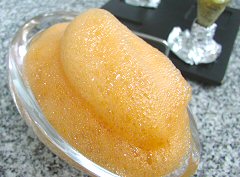 Presuming that that’s unlikely, even though it’s a contribution to the problem, I didn’t pipe up with the observation during my second Cocina de Vanguardia class, where we were treated to an interesting evening of, well, how to blow bubbles in your milk and not have your mother yell at you for it. There are, as we learned, three families of frothed food – airs, foams, and sponges – each progressively more stable, and, in general, more manipulated. The basic differences come down to the following, though there’s clearly some overlap – an air is an emulsion, something that is whipped with air, whether via whisk or hand blender, it’s a product of the primary material, involving something that has a “tensoactive protein” in it – whether an egg yolk or white, or as in the case of this “carrot air”, a bit of powdered coconut milk. Even with that hint of coconut and a bit of curry, I simply can’t imagine myself sitting down to eat a bowl of the stuff. It also collapses pretty quickly and you end up with what, in fact, you’re really eating, spiced carrot juice.
Presuming that that’s unlikely, even though it’s a contribution to the problem, I didn’t pipe up with the observation during my second Cocina de Vanguardia class, where we were treated to an interesting evening of, well, how to blow bubbles in your milk and not have your mother yell at you for it. There are, as we learned, three families of frothed food – airs, foams, and sponges – each progressively more stable, and, in general, more manipulated. The basic differences come down to the following, though there’s clearly some overlap – an air is an emulsion, something that is whipped with air, whether via whisk or hand blender, it’s a product of the primary material, involving something that has a “tensoactive protein” in it – whether an egg yolk or white, or as in the case of this “carrot air”, a bit of powdered coconut milk. Even with that hint of coconut and a bit of curry, I simply can’t imagine myself sitting down to eat a bowl of the stuff. It also collapses pretty quickly and you end up with what, in fact, you’re really eating, spiced carrot juice.
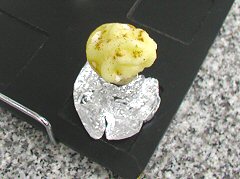 I can’t say I even found this one attractive to look at. It’s a “cono espumoso en 2 temperaturas” – though that’s a bit of a misnomer – the cone itself is not foaming or foamed or foamy. It’s a nice little, flavorful cone made of a couple of layers of filo dough sprinkled with five spice powder, brushed with butter, and sandwiched between two cone molds to keep the shape, and then baked until crisp. The technique of making foams requires some kind of fatty substance in it to allow it to come out as a foam, hence a huge amount of butter added to a green apple puree, allowing you to have it set fairly stable. The two foams – a cold green apple and butter foam and a hot Brie foam – the temperature difference was interesting, the flavor compatibility between the two was nil. That doesn’t mean that one can’t combine apples and Brie, but for whatever reason, these two were just unpleasant together. And what makes these foams? They’re tossed into a whipped cream canister, out come those nitrous oxide canisters, and shortly thereafter, one can pipe Brie, apples, cod, or raspberries, or whatever substance strikes your fancy.
I can’t say I even found this one attractive to look at. It’s a “cono espumoso en 2 temperaturas” – though that’s a bit of a misnomer – the cone itself is not foaming or foamed or foamy. It’s a nice little, flavorful cone made of a couple of layers of filo dough sprinkled with five spice powder, brushed with butter, and sandwiched between two cone molds to keep the shape, and then baked until crisp. The technique of making foams requires some kind of fatty substance in it to allow it to come out as a foam, hence a huge amount of butter added to a green apple puree, allowing you to have it set fairly stable. The two foams – a cold green apple and butter foam and a hot Brie foam – the temperature difference was interesting, the flavor compatibility between the two was nil. That doesn’t mean that one can’t combine apples and Brie, but for whatever reason, these two were just unpleasant together. And what makes these foams? They’re tossed into a whipped cream canister, out come those nitrous oxide canisters, and shortly thereafter, one can pipe Brie, apples, cod, or raspberries, or whatever substance strikes your fancy.
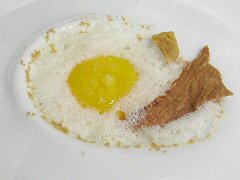 Do I want my breakfast reinterpreted? That’s a question that each of us ought to be asking ourselves, each and every morning. Let me put it this way. I like a nice fried egg and strip of bacon, maybe some toast, all on occasion. It takes a few minutes to make it, and it tastes simply delicious. This reinterpretation takes a lot of work, something I have no interest in that early in the morning. It also doesn’t taste as good as the original. It did involve an interesting technique for making crisp, brittle, crumbly bacon out of slices of prosciutto – laying them out in a single layer between several sheets of paper towel and microwaving on high for three minutes – pulls all the fat out, crisps up the prosciutto, and you can use it, as here, in both a shard form, or crumble a bit into dust in a spice grinder to sprinkle around the plate. The rest of this dish, I’d simply rather not think about – the egg yolk in the center is fine – it’s just there. The “white of the egg”, however, is a stabilized foam made of mixing together the clarified fat off of a prosciutto (you know, melting it all down and straining it), milk, and a substance known as a sucrose ester of fatty acids, which is used to stabilize pure fats so that they can be foamed. Yes indeed, that’ll go over well with my doctor when I tell him that I did indeed give up the extra strip of bacon, in exchange for a foam of melted fat…
Do I want my breakfast reinterpreted? That’s a question that each of us ought to be asking ourselves, each and every morning. Let me put it this way. I like a nice fried egg and strip of bacon, maybe some toast, all on occasion. It takes a few minutes to make it, and it tastes simply delicious. This reinterpretation takes a lot of work, something I have no interest in that early in the morning. It also doesn’t taste as good as the original. It did involve an interesting technique for making crisp, brittle, crumbly bacon out of slices of prosciutto – laying them out in a single layer between several sheets of paper towel and microwaving on high for three minutes – pulls all the fat out, crisps up the prosciutto, and you can use it, as here, in both a shard form, or crumble a bit into dust in a spice grinder to sprinkle around the plate. The rest of this dish, I’d simply rather not think about – the egg yolk in the center is fine – it’s just there. The “white of the egg”, however, is a stabilized foam made of mixing together the clarified fat off of a prosciutto (you know, melting it all down and straining it), milk, and a substance known as a sucrose ester of fatty acids, which is used to stabilize pure fats so that they can be foamed. Yes indeed, that’ll go over well with my doctor when I tell him that I did indeed give up the extra strip of bacon, in exchange for a foam of melted fat…
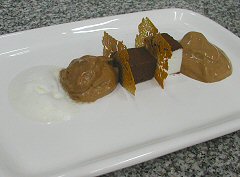 I grew up in a different culture, and a different era – an afternoon snack in our house was usually some fresh fruit. Maybe… maybe… in the heat of summer, we might be allowed a fudgsicle from the Good Humor truck. On occasion. Argentine culture tends towards a sweeter afternoon snack. It’s common to share a round or ten of mate along with a selection of pastries. It tends to be a pretty sugar laden experience. So no surprise that this version of a merienda involves a whole lot of sweet. This introduced us to sponges – which, simply, are frothed up concoctions that make use of some kind of gelling agent – whether gelatin or agar-agar, or something else, that makes them stable. The dish is actually a mix of techiques – an unflavored (i.e., plain milk and sugar) and a choclate sponge, the former coated in cocoa (essentially we’re talking marshmallows) – a vanilla air, and a chocolate foam, all separated by shards of a cute little lacey cookie made by… umm, mashing up some cookes (Bay Biscuits) with water in a food processor, spreading them out really thin on a silpat, and baking them until they’re crisp. We’re essentially talking about a long, reinvented s’more.
I grew up in a different culture, and a different era – an afternoon snack in our house was usually some fresh fruit. Maybe… maybe… in the heat of summer, we might be allowed a fudgsicle from the Good Humor truck. On occasion. Argentine culture tends towards a sweeter afternoon snack. It’s common to share a round or ten of mate along with a selection of pastries. It tends to be a pretty sugar laden experience. So no surprise that this version of a merienda involves a whole lot of sweet. This introduced us to sponges – which, simply, are frothed up concoctions that make use of some kind of gelling agent – whether gelatin or agar-agar, or something else, that makes them stable. The dish is actually a mix of techiques – an unflavored (i.e., plain milk and sugar) and a choclate sponge, the former coated in cocoa (essentially we’re talking marshmallows) – a vanilla air, and a chocolate foam, all separated by shards of a cute little lacey cookie made by… umm, mashing up some cookes (Bay Biscuits) with water in a food processor, spreading them out really thin on a silpat, and baking them until they’re crisp. We’re essentially talking about a long, reinvented s’more.
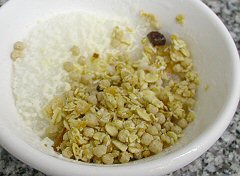 Last up, this strangely named pan de queso, which isn’t any sort of bread at all, but an air of parmesan cheese. I have to admit, this was kind of interesting, even if it does collapse fast – it’s the sort of thing that I could see using to garnish a dish – as opposed to here where it’s served as a bowlful topped with some muesli – though I will say that flavorwise, this was the most interesting dish of the evening, a nice contrast and pairing between the dried fruits and the parmesan. It’s also pretty easy to make – if perhaps a tad on the expensive side – though of course, one could use a different and less expensive cheese I’d imagine. It’s equal parts of water and parmesan, boiled together and then left to sit for 15 minutes to infuse the parmesan flavor into the water. Then it’s strained, a little soy lecithin is added to stabilize it (3% by weight) – which you can pick up at most natural foods stores, it’s chilled, and then whipped with a hand blender. It’s tasty, it just tends to collapse in on itself relatively quickly, though if you’re whipping it just before serving, it will be fine – this sat out during a good portion of the demo class.
Last up, this strangely named pan de queso, which isn’t any sort of bread at all, but an air of parmesan cheese. I have to admit, this was kind of interesting, even if it does collapse fast – it’s the sort of thing that I could see using to garnish a dish – as opposed to here where it’s served as a bowlful topped with some muesli – though I will say that flavorwise, this was the most interesting dish of the evening, a nice contrast and pairing between the dried fruits and the parmesan. It’s also pretty easy to make – if perhaps a tad on the expensive side – though of course, one could use a different and less expensive cheese I’d imagine. It’s equal parts of water and parmesan, boiled together and then left to sit for 15 minutes to infuse the parmesan flavor into the water. Then it’s strained, a little soy lecithin is added to stabilize it (3% by weight) – which you can pick up at most natural foods stores, it’s chilled, and then whipped with a hand blender. It’s tasty, it just tends to collapse in on itself relatively quickly, though if you’re whipping it just before serving, it will be fine – this sat out during a good portion of the demo class.
So, there you have our introductory class in bubbles – some interesting ideas to at least think about…